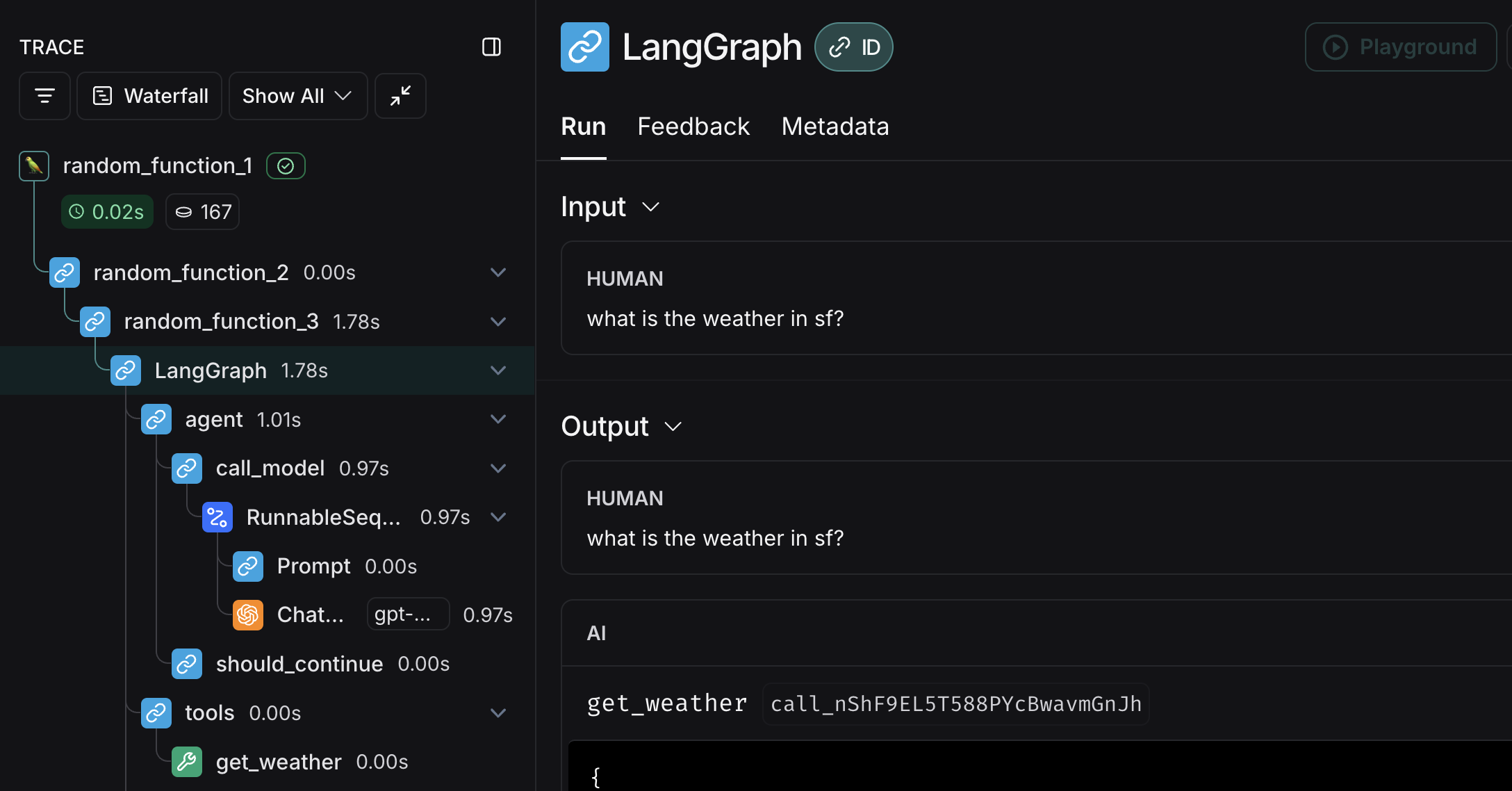Tracing PromptFlow applications in LangSmith
Introduction
This tutorial shows how to correctly trace a PromptFlow application in LangSmith. It covers initial setup, creating nested traces between nodes, and integrating LangGraph within a PromptFlow tool.
Prerequisites
Before getting started, make sure you have:
- PromptFlow installed and configured
- LangSmith API key set up in your environment
- Basic understanding of PromptFlow's DAG structure
Setting up LangSmith tracing in PromptFlow
Basic node setup
When creating a PromptFlow application, each node can be traced as a separate trace in LangSmith. To achieve this, you use the @traceable decorator from LangSmith along with the @tool decorator from PromptFlow.
Here's the basic structure for a node:
from promptflow.core import tool
import langsmith as ls
@ls.traceable(run_type="chain")
@tool
def my_tool_function(input_parameter: str) -> str:
# Your logic here
processed = f"Processed: {input_parameter}"
return processed
Creating nested traces
To create nested traces (where one trace is a child of another), you need to:
- Get the current run tree headers in the parent node
- Pass those headers to the child node via the
langsmith_extraparameter - Use those headers in the child node
Parent node example
from promptflow.core import tool
import langsmith as ls
from langsmith.run_helpers import get_current_run_tree
@ls.traceable(run_type="chain")
@tool
def parent_node(input_text: str) -> dict:
# Your custom logic here
processed = f"Processed: {input_text}"
# Get current run tree headers to pass downstream
run_tree = get_current_run_tree()
headers = run_tree.to_headers() if run_tree else {}
return {
"processed": processed,
"langsmith_extra": {
"parent": headers
}
}
Child node example
from promptflow.core import tool
import langsmith as ls
@ls.traceable(run_type="chain")
@tool
def child_node(processed_text: str, langsmith_extra: dict = None) -> str:
# Your logic here
enhanced_text = f"Enhanced: {processed_text}"
return enhanced_text
Flow YAML configuration
Here's how to configure the flow.dag.yaml to connect these nodes with proper trace propagation:
inputs:
user_input:
type: string
outputs:
final_output:
type: string
reference: ${child.output}
nodes:
- name: parent
type: python
source:
type: code
path: parent_node.py
function: parent_node
inputs:
input_text: ${inputs.user_input}
- name: child
type: python
source:
type: code
path: child_node.py
function: child_node
inputs:
processed_text: ${parent.output.processed}
langsmith_extra: ${parent.output.langsmith_extra}
Important considerations
-
Return type: Make sure to correctly specify the return type of your function in the function signature to match what you're actually returning.
-
Headers propagation: Always check if the run_tree exists before calling to_headers() to avoid errors.
Using LangGraph with PromptFlow and LangSmith
You can run a LangGraph graph inside a PromptFlow tool, and it will be automatically traced within LangSmith. Here's an example:
from promptflow.core import tool
import langsmith as ls
from langgraph.prebuilt import create_react_agent
from langchain_openai import ChatOpenAI
from langchain_core.tools import tool as langchain_tool
# Define a tool for the LangGraph agent
@langchain_tool
def get_weather(city):
"""Get weather information for a city."""
if city == "nyc":
return "Cloudy in NYC"
elif city == "sf":
return "Sunny in SF"
else:
return "Unknown city"
# Create the agent
model = ChatOpenAI(model="gpt-4o-mini")
tools = [get_weather]
agent = create_react_agent(model, tools=tools)
@ls.traceable(run_type="chain")
@tool
def graph_node(input_text: str, langsmith_extra: dict = None) -> str:
# Process the input
processed = f"Processing query: {input_text}"
# Invoke the LangGraph agent
response = agent.invoke({
"messages": [{"role": "user", "content": input_text}]
})
return f"Agent response: {response}"
This will produce the following trace tree in LangSmith:

Find out more about nested traces in LangSmith here.